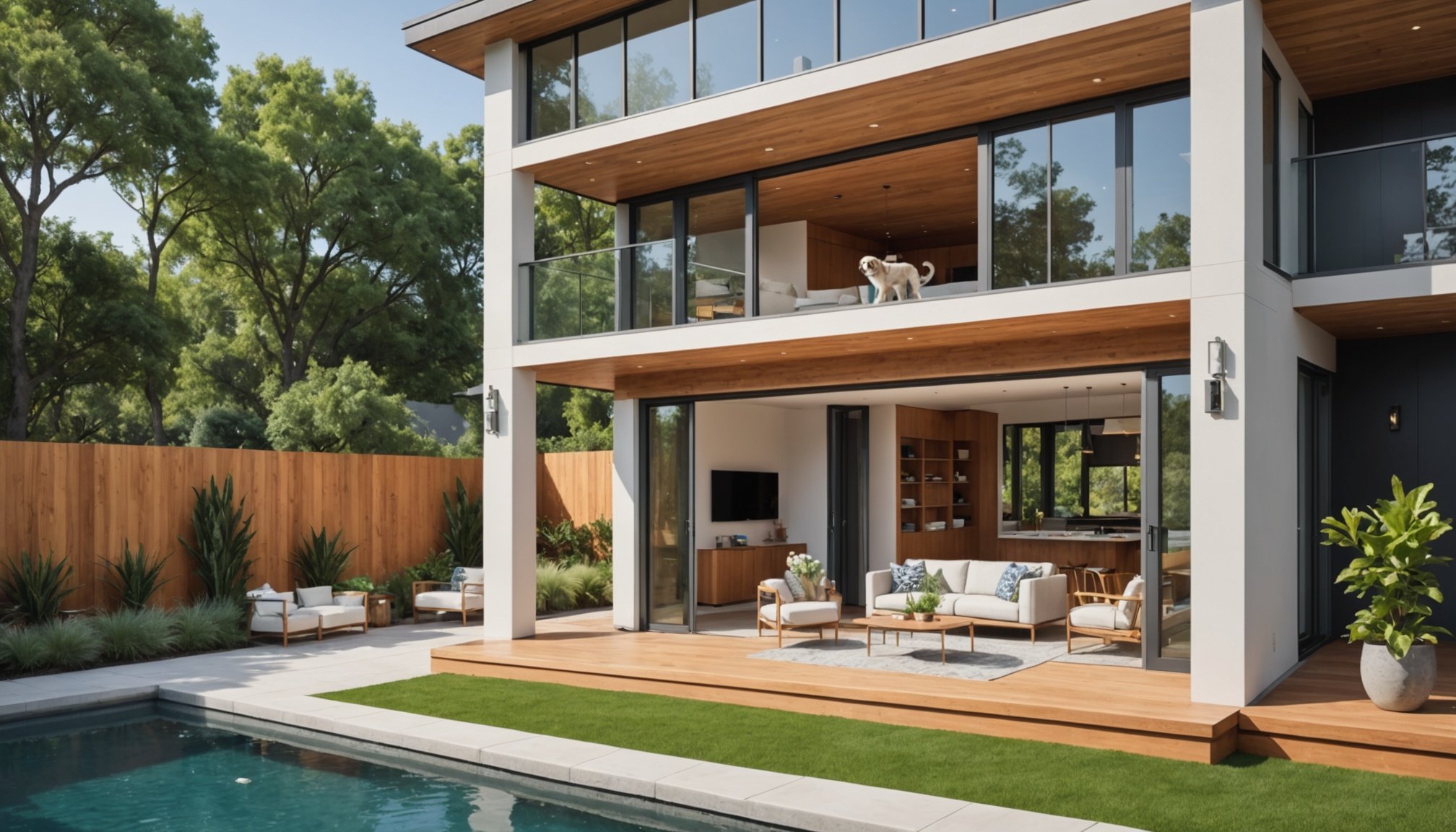Innovative Design Ideas for Seamless Indoor-Outdoor Living
Blurring the lines between indoors and outdoors is a hallmark of modern home design. Seamless indoor-outdoor design creates a fluid space that is both practical and aesthetically pleasing. The key is a harmonious connection, achieved through thoughtful planning and execution.
Essential features include large sliding doors and foldable walls, enabling easy transitions between spaces. These elements offer flexibility, transforming areas into open vistas when desired. Such accessibility not only enhances the appeal but also increases the usability of patios and decks. These outdoor extensions act as additional living spaces, perfect for relaxation and entertainment.
Also to discover : Transform Your Kitchen: Clever Hacks for Ultimate Organization and Reducing Food Waste
Incorporating pet-friendly architecture is vital for homeowners with furry companions. Design elements such as broad walkways and protected outdoor areas allow pets the freedom to roam safely. A unified landscape not only caters to the household’s needs but also adds value to the property by enhancing its overall functionality.
By focusing on bridging indoor and outdoor zones, you can foster an inviting ambiance. Thoughtful integration not only maximises space but also accommodates modern living demands, blending nature’s beauty with the comforts of home. Creative architectural solutions can make any abode both welcoming and efficiently designed, satisfying every resident, including four-legged family members.
Topic to read : Transform Your Home Gym: Design a Vibrant Color Scheme to Boost Focus and Motivation
Pet-Friendly Materials for Modern Homes
Modern homes benefit from pet-friendly interior design by incorporating durable materials that withstand the daily activities of pets. Noteworthy are surfaces that resist scratches and stains, ensuring longevity and maintenance ease. Hardwoods such as oak or bamboo, alongside tiles and laminate flooring, offer resilience without sacrificing aesthetics. Additionally, these materials are practical for high-traffic areas, enabling smooth transitions between indoor and outdoor zones.
Eco-friendly options are increasingly popular, providing safe and sustainable choices for pet owners. Cork and linoleum, for instance, combine durability with environmental benefits, being both renewable and biodegradable. When choosing finishes, look for non-toxic paints and varnishes to ensure these elements do not pose health risks to pets, thus contributing to overall home safety.
Selecting the right materials entails more than durability; it involves ensuring pets coexist harmoniously within the living environment. This involves balancing aesthetic appeal with functional needs, considering textures that provide comfort while maintaining resilience. Designing with pets in mind means integrating both practicality and style, resulting in homes that cater to humans and their animal companions. Emphasising non-toxic options, durability, and eco-friendliness delivers a holistic approach to pet-friendly modern living.
Creating Seamless Transitions for Pets
Integrating indoor-outdoor flow in modern homes ensures a harmonious environment for pets. It’s essential to consider various home layout design features that facilitate smooth transitions. Pets require unobstructed movement, both inside and outside the home, which can be achieved through pet transitions.
Design Features Enhancing Indoor-Outdoor Flow
A key element in enhancing flow is the strategic use of doors and windows. Large, sliding doors and foldable walls allow pets to move effortlessly between spaces, promoting a sense of freedom and accessibility. This design choice not only facilitates pet transitions but also extends the home’s living areas into the outdoors.
Flooring Choices for Easy Movement
Selecting the right flooring is crucial. Opt for durable surfaces that endure wear and tear. Materials like hardwood and tile are ideal, allowing pets to navigate comfortably without slipping and withstands scratches. These surfaces ensure seamless transitions, reducing physical barriers.
Strategic Placement of Access Points
Be strategic with the placement of access points, such as pet doors, ensuring they are at convenient locations for pets. This enhances ease of navigation and supports a unified indoor-to-outdoor experience. Properly placed doorways ensure that pets can access outdoor spaces safely.
Expert Advice for Modern Home Design with Pets
Creating a pet-friendly environment in a modern home design involves more than just durable materials. Experts agree that understanding pet behavior is crucial. Architect Julia Summers highlights that considering pets’ natural tendencies can inform design choices, leading to more functional spaces. For instance, pets often prefer certain paths through the house, making their behavioural patterns significant in home layout design.
To effectively integrate pets into your living space, professionals recommend collaborating with pet care specialists. Engaging these experts during the planning phase can offer insights into pet needs, ensuring homes are both pet-friendly and practical. Architectural designer Mark Elliot suggests consulting veterinarians or animal behaviorists for tailor-made advice, enhancing the harmony of pet integration.
Designers also emphasize flexibility in pet integration. Opt for multipurpose furniture to maximize accessibility and adaptability. Adding elements such as built-in pet beds or storage areas can seamlessly incorporate pets’ essentials without compromising the aesthetic of your modern home. These adaptable solutions facilitate a seamless indoor-outdoor flow, granting pets freedom while maintaining your home’s stylish integrity.
Case Studies of Successful Indoor-Outdoor Living Spaces
In exploring real-life examples of indoor-outdoor living spaces, key features emerge that effectively merge functionality with aesthetics. Successful designs frequently incorporate clever architectural elements like large sliding doors and foldable walls, forming seamless transitions. For instance, the use of these elements in a Californian bungalow allowed for the living room to completely open up onto a spacious patio, illustrating how modern architecture can transform areas into expansive, versatile environments.
Home Case Study: Open Concept Living with Pet Access
An Australian home exemplifies an open concept living strategy with thoughtful pet access solutions. By situating pet-friendly walkways and access points, this design caters to both human and animal inhabitants. It allows pets to roam comfortably without compromising the overall aesthetic.
Case Study: Incorporating Landscaping for Pet Safety
In another instance, a Scandinavian home uses landscaping to enhance pet safety. Positioned strategically, plants and soft ground covers create a welcoming environment for pets, enriching outdoor navigation while maintaining an attractive setting.
Analysis of Multi-functional Spaces for Pet Care
The ability to analyse multi-functional spaces is crucial, as shown in a Tokyo apartment, where integrated furniture designs, such as built-in pet nooks, elevate compact living areas into efficient, pet-friendly habitats.

